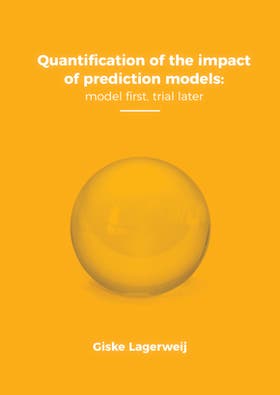Giske Lagerweij
Quantification of the impact of prediction models: model first, trial later

- Datum
- (Co) promotoren
- 12-03-2019
- prof.dr. K.G.M. Moons, dr. ir. H. Koffijberg, dr. G.A. de Wit,
Samenvatting
Massive numbers of new prediction models have been published over the past two decades and the number of developed prediction models increases every week. Numerous guidelines and books have proposed a stepwise process in prediction modeling before the model is implemented in daily practice or recommended in clinical guidelines. Subsequently, one needs to quantify to what extent the actual implementation of a successfully validated prediction model, as compared to not using the model, impacts decision making. . Alike every diagnostic or prognostic test or device, prediction models are ‘information generating tools’ that only indirectly impact healthcare and economic outcomes. Therefore, the final step in the process of prediction modeling should be the evaluation of the health and healthcare outcomes of the targeted population of the implementation of the prediction model versus usual care should be evaluated. However, impact evaluations of prediction models are still rarely performed. This thesis describes the challenges and potential solutions for impact evaluations of prediction models for cardiovascular diseases (CVD). Prediction models for CVD are often prognostic models that predict outcomes over a longer period of time although CVD risk factors may already be present at young age. To evaluate the impact of prediction models for CVD in a randomized comparative trial is therefore costly, time consuming and almost infeasible due to the long period of time. A model based approach may be more promising. In this thesis, multiple model-based approaches are performed to evaluate the impact of the implementation of prediction models for preventive interventions for CVD.
